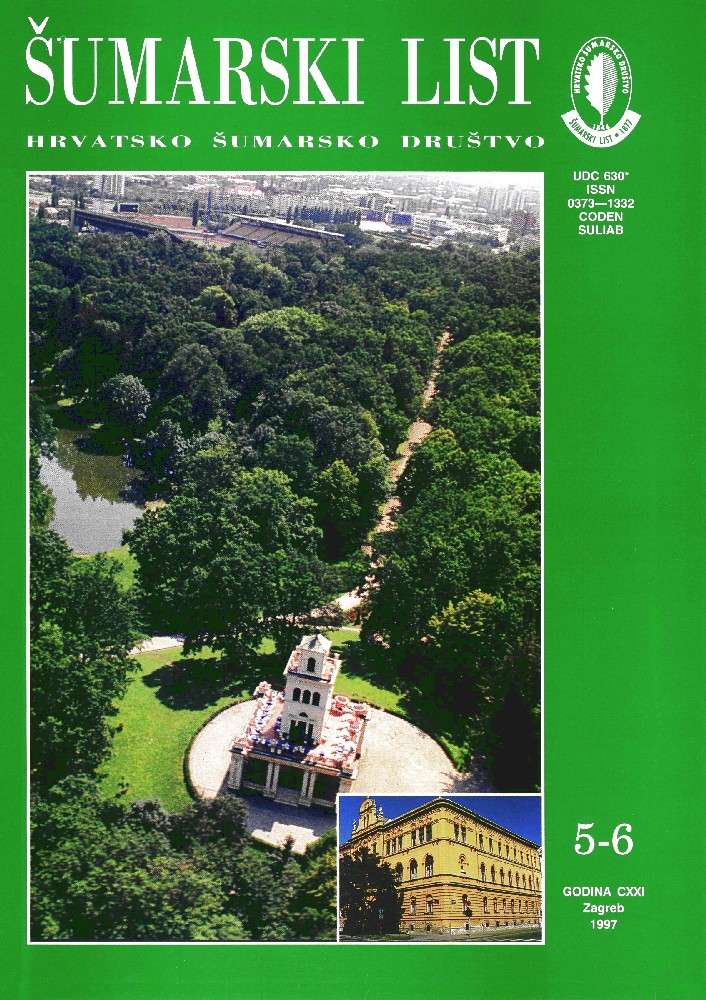
broj: 5-6/1997
pdf (31,9 MB) |
|
||||||||||||||
| IZVORNI ZNANSTVENI ČLANCI | ||
| Pintarić, K. | UDK 630* 231+236.001 (Pinus nigra Arn.) | |
| The Analysis of the Structure and Quality of the Natural Black Pine Young Growth pdf HR EN | 215 | |
| Matić, S., Prpić, B. | UDK 630* 272+249:630* 652+907.001 | |
| The Programme of Tending and Maintenance, the Ecological and Social Functions of the Zagreb Park Forest pdf HR EN | 225 | |
| Summary: Today´s park forests of Zagreb are the remnants of the ancient natural forests that covered today´s urbanized Zagreb area. This paper describes 17 parks covering altogether 1,258.55 ha, while all park forests of Zagreb amount to 2,400 ha. Greatly retaining their natural composition, Zagreb park forests stretch along the Sava valley and the southeast hillsides of the mountain Medvednica. On the hills grow the sessile-flowered oaks and submontane beeches. In the Sava valley thrive the pubescent oak forests, while the willow and poplar associations appear wherever there are floods. Woven throughout the city, these precious forests raise the question of how to tend them. Protected by law, though not by their genesis, structure and development, they do not differ from the classical management forests, except for the management targets. Park forests serve only for ecological and social purposes, i.e. hydrology; fight against erosion and pollution; in terms of their climatic, recreational and health functions. The silvicultural topics of this paper have been dealt with in phases, which include the revitalization steps such as improvements of the soil for natural regeneration, and if necessary, artificial supplements, young stand protection, tending of young trees and stands by clearing and thinning, as well as other operations that improve the social and ecological forest functions. Suggestions for silvicultural care of all 17 park forest areas have been given. The ecological and social forest functions are described with the criteria for the evaluation of the generally valuable functions, so that the total value of all 17 areas amounts to over 4 billion kunas (1.13 billion DEM). The following conclusions have been made after the research done in the Zagreb park forests: 1) The management methods used for park forests and those for common forests differ by their targets. The latter improve the technical value of the trees while supporting the value of the ecological and social forest functions. In the park forests, the focus of the operations is the improvement of their ecological and social values. Crucial is the maintenance of the biological diversity by supporting the mixed stands consisting of the trees corresponding to the given habitat. 2) In order to stimulate the binding of the carbon dioxide and the release of oxygen in the process of photosynthesis, a high producibility of the ecologically balanced forest stand should be sustained. This target can be met by normal measures of the classical silviculture, adjusted to the purposes of the park forest. 3) Even-aged or regular park forests, either low, medium or high in their silvicultural form, should be renewed in a combined way. In most cases,this is done by the procedures of the regeneration cuts on small areas combined with the regeneration through fringe cuts with relatively long regeneration periods. The reason for regeneration is the physiological age of the trees with the disturbance of the physiological processes, which reduces the ecological forest value (reducedphotosynthesis, increased transpiration and breathing). 4) Single social functions of the park forests should be thoroughly investigated for their quantification in terms of planning forest protection (soil treading, tree damage, etc.). 5) Considering the extremely unfavourable chemical impacts of the wet toxic sediments, the damage degrees on the selected bio-indicative points should be established before deciding on the change of habitat and the appropriate measures. | ||
| Bojanin, S., Krpan, A. P. B. | UDK 630* 312+379:630* 419.001 | |
| Adjustement of the Skidding Technology to Forest Protection pdf HR EN | 243 | |
| Perić, Z. | UDK 630* 165.001 (Larix decidua Mill.) | |
| Interclonal and Clonal Differences in a Seed Orchard of European Larch (Larix decidua Mill.) near Bjelovar pdf HR EN | 253 | |
| Jurković, M., Jurković-Bevilacqua, B. | UDK 630* 175.272:181.2.001 | |
| The Contribution to the Introduction and Acclimatization of Exotic Woody Plants - Deciduous Trees in the Parks of Zagreb pdf HR EN | 269 | |
| PREGLEDNI ČLANCI | ||
| Đurasović, P. | UDK 630* 279:232.1 | |
| The Introduction of Exotic Trees and Shrubs in the Region of Dubrovnik pdf HR EN | 277 | |
| STRUČNI ČLANCI | ||
| Nekvapil, N. | UDK 630* 628 | |
| Forest Management of the "Bastaji Forest - Krivaja - Klisa" pdf HR EN | 291 | |


